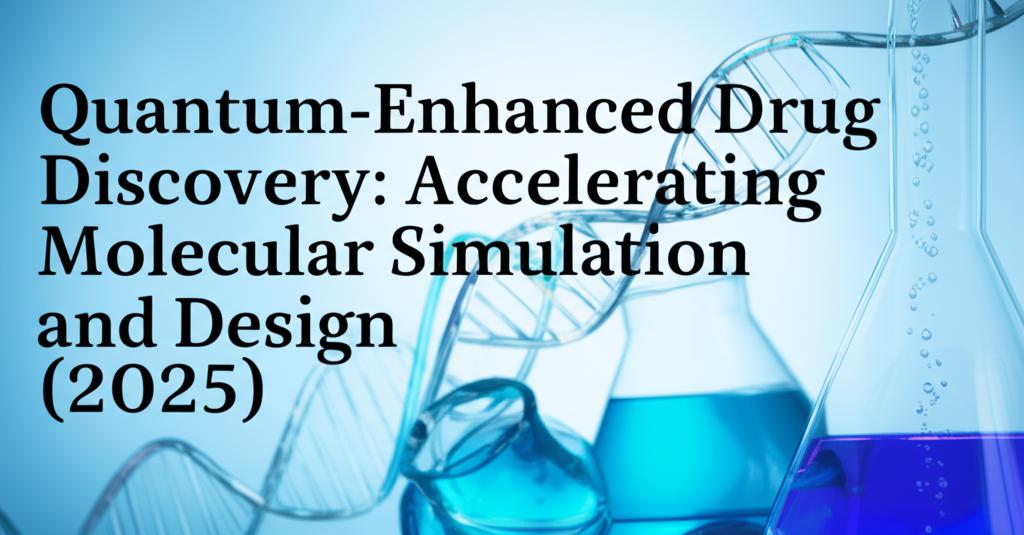The pharmaceutical industry is on the cusp of a revolution, driven by the extraordinary capabilities of quantum computing. Traditional drug discovery is a notoriously lengthy, expensive, and often inefficient process, with countless potential drug candidates failing in late-stage trials. However, quantum-enhanced approaches are poised to dramatically accelerate molecular simulation and design, ushering in a new era of rapid and precise therapeutic development.
At the heart of this transformation lies the ability of quantum computers to tackle complex molecular calculations that are far beyond the reach of even the most powerful classical supercomputers. Molecules, by their very nature, are quantum systems. Simulating their behavior accurately—understanding how they interact, bind to targets, and their quantum mechanical properties—requires computational tools that can natively speak this quantum language.
Unlocking Molecular Mysteries with Quantum PrecisionQuantum computers leverage phenomena like superposition and entanglement to perform calculations in a fundamentally different way. This allows them to:
- Simulate Larger and More Complex Molecules: Classical methods often rely on approximations when dealing with large biomolecules like proteins or nucleic acids due to the exponential increase in computational demand with molecular size. Quantum algorithms promise to simulate these systems with significantly higher fidelity, providing deeper insights into their structure, dynamics, and interaction energies. This is crucial for understanding disease mechanisms and designing drugs that can effectively modulate biological targets.
- Improve Quantum Chemistry Calculations: Key to drug design is predicting properties like binding affinities (how strongly a drug candidate binds to its target protein) and reaction rates. Quantum computers can perform these quantum chemistry calculations—such as determining the ground state energy of a molecule or simulating molecular dynamics—with greater accuracy. This can lead to more reliable predictions of a drug's efficacy and pharmacokinetic profile (how it's absorbed, distributed, metabolized, and excreted).
- Enhance Quantitative Structure-Activity Relationship (QSAR) Modeling: QSAR models are used to predict the biological activity of compounds based on their chemical structure. Quantum machine learning algorithms, running on quantum computers, could potentially uncover more subtle and complex relationships between molecular features and activity, leading to more predictive QSAR models and the faster identification of promising drug candidates.
- Optimize Molecular Docking and Protein Folding: Understanding how a drug molecule fits into the binding site of a target protein (molecular docking) and how proteins fold into their functional three-dimensional shapes are critical but computationally intensive tasks. Quantum algorithms are being developed to explore vast conformational spaces more efficiently, speeding up the identification of optimal binding modes and predicting protein structures with greater accuracy.
The enhanced capabilities in molecular simulation translate directly into a more efficient drug design pipeline:
- Faster Candidate Identification: By accurately predicting the properties of vast libraries of virtual compounds, quantum computers can help researchers quickly identify the most promising drug candidates, significantly reducing the number of compounds that need to be synthesized and tested experimentally.
- Improved Lead Optimization: Once initial candidates (hits) are identified, they often need to be modified to improve their efficacy, reduce toxicity, or enhance their pharmacokinetic properties. Quantum simulations can guide this optimization process by predicting how specific chemical modifications will impact the molecule's behavior.
- Personalized Medicine: As quantum computing matures, it could enable the design of drugs tailored to an individual's genetic makeup or specific disease subtype, leading to more effective and safer treatments.
While the full potential of quantum drug discovery is still on the horizon, significant progress is being made. By 2025 and in the immediate years following, we anticipate:
- Hybrid Quantum-Classical Approaches: In the near term, the most impactful applications will likely involve hybrid systems where quantum processors tackle specific, computationally challenging parts of a problem, while classical computers handle other aspects. This pragmatic approach leverages the strengths of both technologies.
- Development of More Sophisticated Quantum Algorithms: Researchers are continuously refining existing quantum algorithms and developing new ones specifically tailored for molecular simulation and drug discovery tasks. This includes improvements in algorithms for electronic structure calculations, molecular dynamics, and machine learning.
- Growth in Quantum Hardware: The number of qubits, their quality (coherence times and gate fidelities), and overall system stability are steadily improving. While fault-tolerant quantum computers are still some way off, the increasingly powerful noisy intermediate-scale quantum (NISQ) devices are becoming capable of performing meaningful calculations for smaller molecular systems, offering valuable insights and proof-of-concept demonstrations.
- Increased Collaboration and Investment: Pharmaceutical companies, tech giants, startups, and academic institutions are increasingly collaborating and investing heavily in this field. This ecosystem is crucial for driving innovation, developing new tools, and establishing best practices.
- Focus on Demonstrable Quantum Advantage: The emphasis will be on identifying specific drug discovery problems where quantum computers can demonstrably outperform classical methods, even if for smaller or simplified systems initially. These early wins will be crucial for building confidence and guiding further development.
Despite the excitement, challenges remain. Building and controlling large-scale, fault-tolerant quantum computers is an immense engineering feat. Developing robust quantum algorithms that can provide a significant advantage over classical methods for real-world drug discovery problems also requires ongoing research and innovation.
Nevertheless, the trajectory is clear. Quantum-enhanced drug discovery is transitioning from a theoretical possibility to an emerging practical tool. As quantum hardware and algorithms continue to mature, their impact on accelerating molecular simulation and revolutionizing the design of new medicines will only grow, bringing hope for faster access to novel therapies for a wide range of diseases. The journey is complex, but the potential rewards—transforming human health—are immeasurable.

